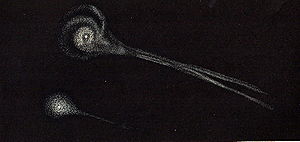
Back مذنب مفقود Arabic Cometa perdut Catalan Cometa perdido Spanish دنبالهدار گمشده Persian Comète perdue French Izgubljeni komet Croatian Կորսված գիսաստղեր Armenian Cometa perduta Italian 見失われた彗星 Japanese 잃어버린 혜성 Korean

A lost comet is one which was not detected during its most recent perihelion passage. This generally happens when data is insufficient to reliably calculate the comet's location or if the solar elongation is unfavorable near perihelion passage. The D/ designation is used for a periodic comet that no longer exists or is deemed to have disappeared.[1]
Lost comets can be compared to lost asteroids (lost minor planets), although calculation of comet orbits differs because of nongravitational forces, such as emission of jets of gas from the nucleus. Some astronomers have specialized in this area, such as Brian G. Marsden, who successfully predicted the 1992 return of the once-lost periodic comet Swift–Tuttle.
- ^ "Cometary Designation System". Minor Planet Center. Retrieved 2015-06-17.